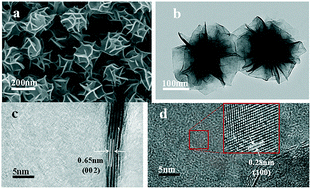当前位置:
X-MOL 学术
›
CrystEngComm
›
论文详情
Our official English website, www.x-mol.net, welcomes your
feedback! (Note: you will need to create a separate account there.)
Phosphine-free synthesis and shape evolution of MoSe2 nanoflowers for electrocatalytic hydrogen evolution reactions
CrystEngComm ( IF 2.6 ) Pub Date : 2018-02-21 00:00:00 , DOI: 10.1039/c8ce00159f Chi Zhang 1, 2, 3, 4 , Xing Chen 1, 2, 3, 4 , Zhiwei Peng 5, 6, 7, 8 , Xiaoming Fu 1, 2, 3, 4, 9 , Linyuan Lian 1, 2, 3, 4, 10 , Wei Luo 1, 2, 3, 4, 10 , Jianbing Zhang 1, 2, 3, 4, 10 , Honglang Li 4, 11, 12, 13 , YuHuang Wang 5, 6, 7, 8 , Daoli Zhang 1, 2, 3, 4, 5
CrystEngComm ( IF 2.6 ) Pub Date : 2018-02-21 00:00:00 , DOI: 10.1039/c8ce00159f Chi Zhang 1, 2, 3, 4 , Xing Chen 1, 2, 3, 4 , Zhiwei Peng 5, 6, 7, 8 , Xiaoming Fu 1, 2, 3, 4, 9 , Linyuan Lian 1, 2, 3, 4, 10 , Wei Luo 1, 2, 3, 4, 10 , Jianbing Zhang 1, 2, 3, 4, 10 , Honglang Li 4, 11, 12, 13 , YuHuang Wang 5, 6, 7, 8 , Daoli Zhang 1, 2, 3, 4, 5
Affiliation

|
MoSe2 represents important layered transition metal dichalcogenides (TMDs) that have high electrocatalytic activity in the hydrogen evolution reaction (HER). A key issue to achieve excellent electrochemical properties of MoSe2 is to synthesize nanostructures that are composed of few-layered MoSe2 with abundant exposure of active edge sites. Nanoflowers of layered materials are promising building blocks for photocatalysis due to their large specific surface area and a wealth of exposed edge sites. In this work, free-standing colloidal MoSe2 nanoflowers, with a size of 250 nm, were synthesized by employing a quick and nontoxic phosphine-free solution-processing approach. Oleic acid (OA), 1-octadecene (ODE) and 1-octylamine (OLA) were primarily used as solvents to control the morphology of MoSe2 nanostructures. Experimental results revealed that the shape evolution of MoSe2 nanostructures started with a first fast precipitation of amorphous materials followed by crystallization of a few layers of nanosheets. The prepared MoSe2 nanoflowers demonstrated excellent HER activities with low overpotentials and small Tafel slopes, and the chronopotentiometry responses revealed good stability, making them promising materials for the electrocatalytic HER.
中文翻译:

MoSe 2纳米花的无磷合成和形状演化,用于电催化的析氢反应
MoSe 2代表重要的层状过渡金属二硫化氢(TMD),在氢释放反应(HER)中具有高电催化活性。实现MoSe 2优异的电化学性能的关键问题是合成由很少层的MoSe 2组成的纳米结构,该结构具有大量的活性边缘位点。层状材料的纳米花由于其较大的比表面积和大量的暴露边缘位点,因此有望成为光催化的基础材料。在这项工作中,独立的胶体MoSe 2通过使用快速且无毒的无磷化氢溶液加工方法合成了大小为250 nm的纳米花。油酸(OA),1-十八碳烯(ODE)和1-辛胺(OLA)主要用作控制MoSe 2纳米结构形态的溶剂。实验结果表明,MoSe 2纳米结构的形状演变始于非晶材料的首次快速沉淀,然后结晶了几层纳米片。制备的MoSe 2纳米花表现出出色的HER活性,具有低的超电势和小的Tafel斜率,计时电位法响应显示出良好的稳定性,使其成为用于电催化HER的有希望的材料。
更新日期:2018-02-21
中文翻译:

MoSe 2纳米花的无磷合成和形状演化,用于电催化的析氢反应
MoSe 2代表重要的层状过渡金属二硫化氢(TMD),在氢释放反应(HER)中具有高电催化活性。实现MoSe 2优异的电化学性能的关键问题是合成由很少层的MoSe 2组成的纳米结构,该结构具有大量的活性边缘位点。层状材料的纳米花由于其较大的比表面积和大量的暴露边缘位点,因此有望成为光催化的基础材料。在这项工作中,独立的胶体MoSe 2通过使用快速且无毒的无磷化氢溶液加工方法合成了大小为250 nm的纳米花。油酸(OA),1-十八碳烯(ODE)和1-辛胺(OLA)主要用作控制MoSe 2纳米结构形态的溶剂。实验结果表明,MoSe 2纳米结构的形状演变始于非晶材料的首次快速沉淀,然后结晶了几层纳米片。制备的MoSe 2纳米花表现出出色的HER活性,具有低的超电势和小的Tafel斜率,计时电位法响应显示出良好的稳定性,使其成为用于电催化HER的有希望的材料。











































 京公网安备 11010802027423号
京公网安备 11010802027423号